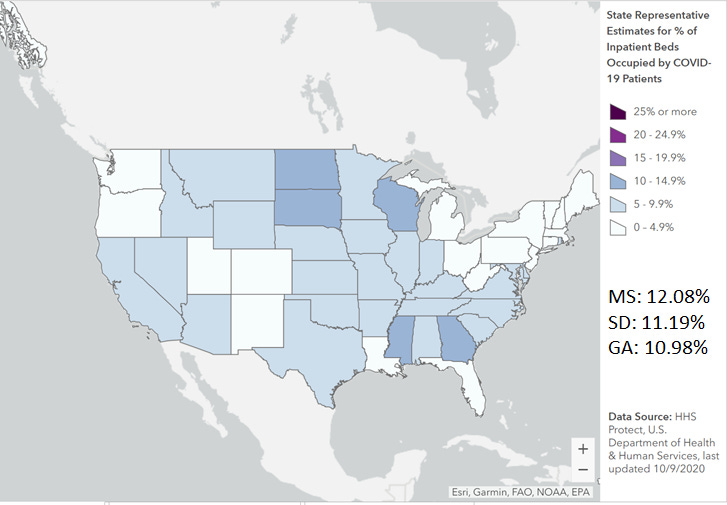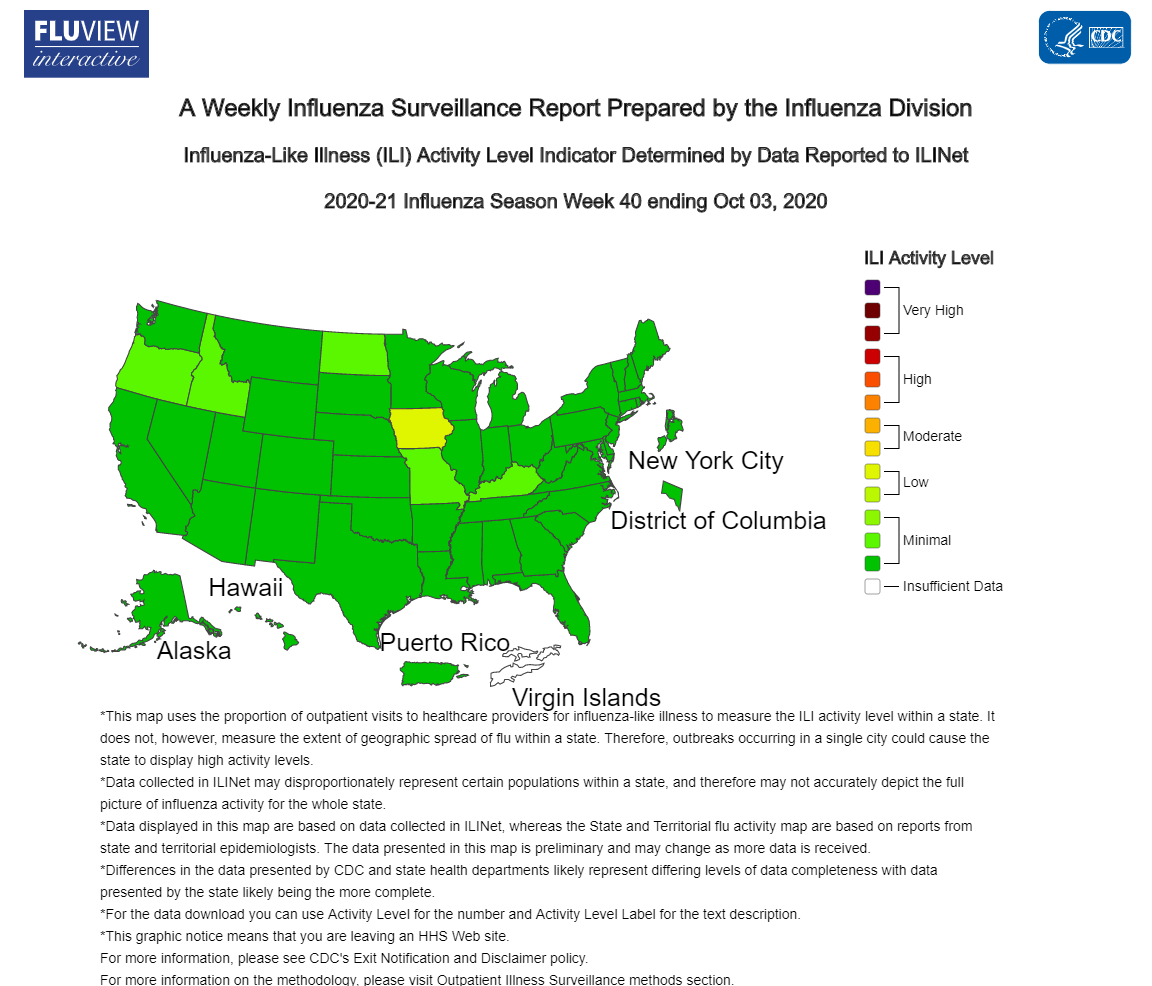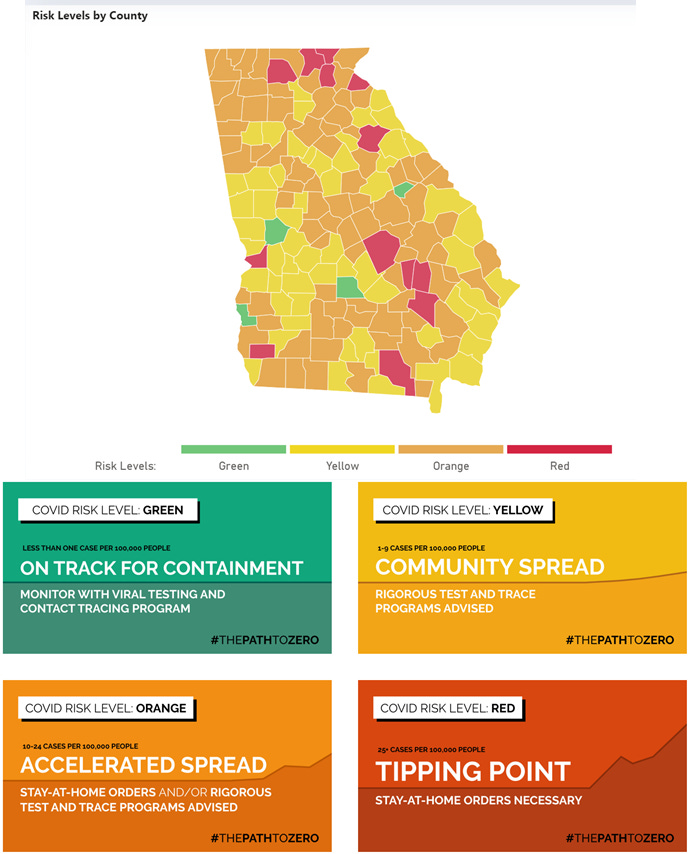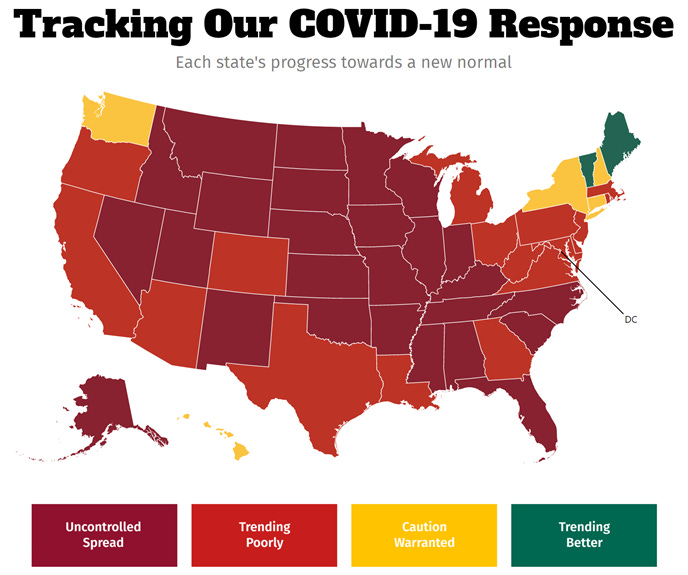The Daily Digest, 12Oct2020
Georgia COVID-19 Updates
The World
Globally, the SARS-CoV-2 virus that causes COVID-19 disease has sickened > 37.6 million people (+2.4 million since last week) and killed 1,077,500 (+40,100 in the past week, which is less than the week preceding it) as of this morning.

The US has rejoined the ranks of the hottest countries in the world for COVID-19 cases after several weeks in the second tier. There are many counties in the Western hemisphere that share this distinction. We are ranked 25th in the world for weekly case rate over the past 7 days. Our weekly case rate per 100,000 is 105 (up from 92). The top five countries for case rate per 100,000 in the past week are Andorra, Czech Republic, Belgium, Montenegro, and Israel.
For deaths, our weekly death rate per 100,000 remains at 1.5 and we are ranked #27 in the world for this (down from #20 last week). So the fact that our death rate held steady but our ranking declined tells you how much deaths are increasing in other parts of the world. The top five countries for death rates per 100,000 this week are Kosovo, Argentina, Montenegro, Ecuador, and Israel.
The United States

As hot spots go, they didn’t move that much this week but got more intense. They are mainly concentrated throughout the Midwest and much of Wisconsin is bright red. As of this morning, there have been over 7.8 million cases and 214,711 deaths in the US. Keep in mind that both of these numbers are probably an under-count of the situation in our country.
Georgia is ranked #33 in the nation for 7-day case rate per 100,000, a drop from #30 last week. Our case rate is 87 per 100,000 in the past 7 days (up from 80 last week). So our case rate is climbing but our ranking is declining. Again, this tells you how much more intense things are in other parts of the country. Keep in mind that most states include the rapid antigen test-identified cases in their case totals whereas Georgia does not. So our case rate is even higher than what the New York Times is counting here. Of the top 10 states for 7-day case rate per 100,000, none are in the South.
Georgia has no counties in the top 20 counties in the nation list for cases per 100,000 in the past week. We also don’t have any cities in the top 20 for case rate per population.
University of Georgia remains the #1 college/university in the nation right now for total cases among students, faculty and staff. Georgia Southern University is ranked #2 in the state for total cases. The state of Georgia ranks #2 for college and university associated cases, behind Texas.
In the past week, Georgia decreased in the rankings from 24th in the nation (180 tests performed per 100,000 in the past 2 weeks) to 38th in the nation (178 tests per 100,000). Together with the Harvard Global Health Institute, they estimate that Georgia is performing at 54% of the ideal testing target (down from 63% last week).
Georgia is now ranked #3 in the nation (down from #1 last week) for proportion of inpatient beds occupied by COVID patients (10.98%), just behind of Mississippi (12.08%) and South Dakota (11.19%). These data come from the Health and Human Services dashboard which was last updated on 09Oct.

We have moved up in the rankings for death rate per 100,000 in the past 7 days, from #13 in the nation last week to #11. Southern states still make up 3 of the top 10 positions on that list, I’m sorry to say.
Here’s the latest look at FluView, showing how influenza-like illness compares across states. The map below depicts how states compare when considering the average percent of outpatient (meaning, not warranting a hospital admission) visits for influenza-like illness for the current week compared to non-influenza season weeks.

The changes compared to last week is that Iowa moved into the yellow (low) zone, Puerto Rico dropped back into minimal levels. Oregon, North Dakota and Kentucky saw increases too. Georgia remains in the most minimal of the minimal section. Keep in mind that influenza is not a mandatory notifiable disease for public health departments like COVID-19 is. But there is a robust surveillance network for tracking trends. So we aren’t likely to see case counts and death counts like we do for COVID-19 because we are seeing estimates for influenza rather than actual numbers. Both diseases feature a wide spectrum of disease severity that can make it hard to identify all cases.
Georgia
Here is how the state of Georgia is looking based on the risk tool from the Harvard Global Health Institute. The color coding is explained below the map.

There are some noticeable improvements this week. There are four green counties compared to five last week. Meanwhile, there are 65 yellow counties this week, compared to 58 last week. For yellow counties, there is community spread that might be manageable with adequate testing and contact tracing. These counties include some of our most populated ones such DeKalb, several of the Atlanta suburb counties, as well as nonrural counties outside of the Atlanta metro. However, the remaining 90 counties have >10 cases per 100,000 people which are color-coded orange and red. So they remain counties of concern. All of the top 10 counties are rural for cases per 100,000 over the past 7 days. Several red counties are concentrated along the Georgia borders. Keep in mind that the Harvard Global Health Institute is only using what Georgia Department of Public Health reports in its case totals…and that case total does not currently include those cases identified by the rapid antigen test. So while many of these counties look like they’re in better shape, we know that antigen testing has driven cases up as much as 33% for some rural counties.
For today, here are the net increases for each key metric for Georgia.
Testing: 17,087 new tests (a low day for us), 6.6% were positive. 124% of today’s cases were identified through electronic laboratory reporting (ELR), so there are a few duplicate results in today’s report. The state counts tests regardless of whether they come from the same person in their calculation of percent positive rate - it is all positive tests divided by all tests performed (positive and negative). However, multiple positive tests from the same person are de-duplicated when case counts are tallied. So the case count is where the correction is made.
Cases: 902 cases (low count for us, probably due to weekend effect). The new statewide total is 332,311. Of today’s cases, 36% came from nonrural counties outside of the Atlanta metro. Atlanta Suburbs contributed 27% of today’s newly reported cases. Rural counties contributed 21% of cases.
Hospitalizations: 21 new COVID hospital admissions and 3 new ICU admissions (these are low numbers for Georgia). We typically see low numbers on Mondays due to delayed reporting over the weekend. There are currently 1252 COVID patients hospitalized and this number is 30 additional patients compared to yesterday. Adult ventilators are being used at 29% of our state’s capacity as of today.
There are three hospital regions that are using over >90% ICU beds: region G (90.4%), H (90%), and N (92%).
Deaths: 13 newly reported deaths. It should be noted that nursing homes typically do not report over the weekends, and Mondays tend to be low count days for this reason. Eleven of the deaths reported today came from outside of the Atlanta metro with rural counties leading with 8 newly reported deaths. The new statewide total is 7429.
The Georgia Department of Public Health did not upload this week’s County Indicators report, probably due to the Columbus Day holiday. Hopefully it will be uploaded tomorrow. This report provides a lot of county level data, including testing, confirmed and probable cases (i.e. those identified through the rapid antigen test) and the counties of concern as far as DPH is concerned. The White House Coronavirus Task Force reports are produced and released on Sundays but I usually don’t get a copy until Monday/Tuesday. So I’ll be back with both of those important reports on Wednesday.
To summarize, Georgia appears to be doing better in several rankings, but that’s really a reflection of how badly things are going elsewhere in the country. The map shown below from COVID Exit Strategy explains what I mean. The vast majority of the country is either trending poorly or showing uncontrolled spread of the disease.

References
https://www.nytimes.com/interactive/2020/us/coronavirus-us-cases.html
https://www.nytimes.com/interactive/2020/world/coronavirus-maps.html
https://protect-public.hhs.gov/pages/hospital-capacity
https://globalepidemics.org/key-metrics-for-covid-suppression/
https://www.cdc.gov/flu/weekly/index.htm
https://dph.georgia.gov/covid-19-daily-status-report
https://covid-gagio.hub.arcgis.com/
https://www.covidexitstrategy.org/
Georgia COVID-19 Updates is a free newsletter that depends on reader support. If you wish to subscribe please click the link below. There are free and paid options available.
My Ph.D. is in Medical Microbiology and Immunology. I've worked at places like Creighton University, the Centers for Disease Control & Prevention and Mercer University School of Medicine. All thoughts are my professional opinion and should not be considered medical advice.
